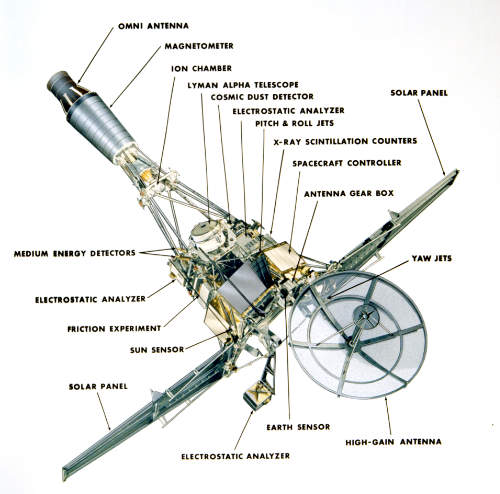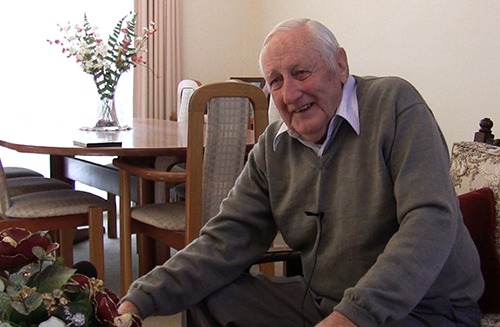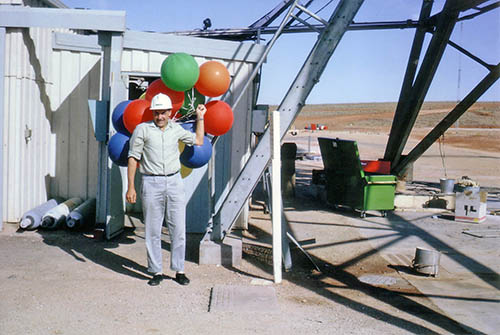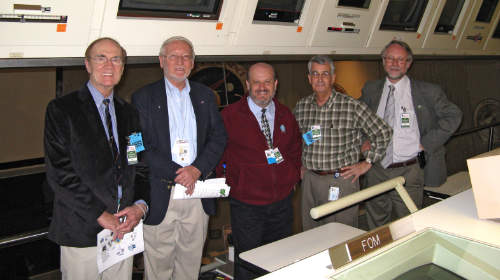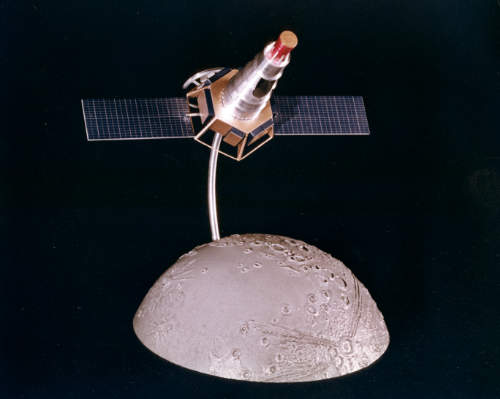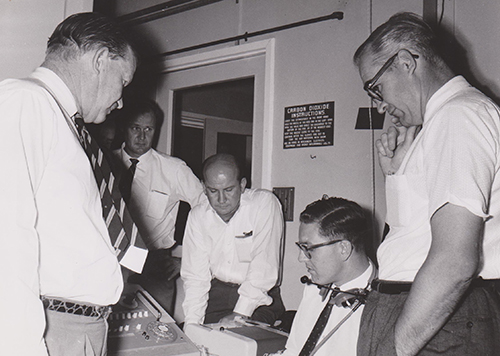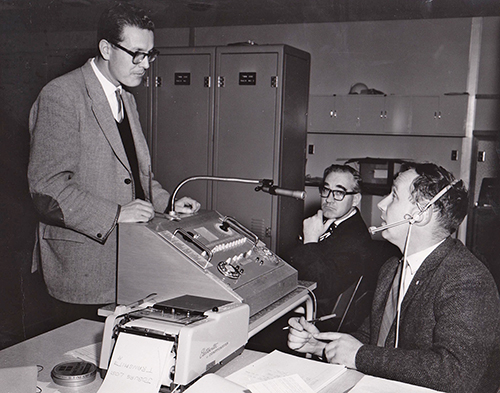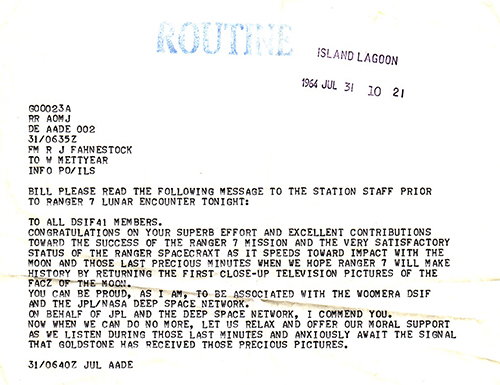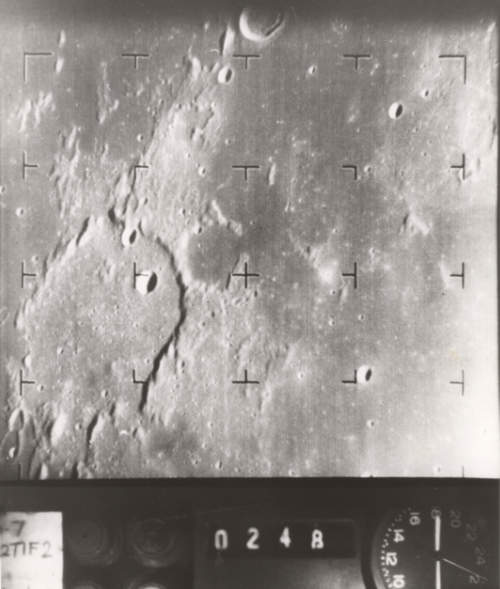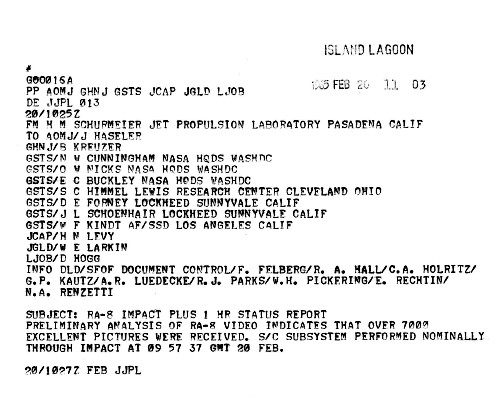During the 1950s the Americans felt confident they were leading the world in technology until they were jolted out of their complacency with the launch of the Russian Sputnik (Russian for “travelling companion”) in October 1957. Newspaper headlines screamed “Red Moon is seen while the world listens to its signals….” “Bleep! And it whirls on,” and the Americans smarted with the announcement “Russia wins the space race.” American President Dwight Eisenhower sniffed, “From what they say they have put one small ball in the air.”
New Zealand born Dr William Pickering, Director of the Jet Propulsion Laboratory (JPL) in Pasadena, California, had an answer. At the time JPL was engaged in a project called Explorer to put a spacecraft into orbit. He suggested that America go for the Moon, and proposed a project he called Red Socks and wanted the Department of Defense to approve a series of 9 flights to the Moon. Initially it met with little interest until a new department called the Advanced Research Projects Agency became temporarily involved in the space business. They were eager to beat the Soviets in any way possible and approved a lunar program in March 1958 called Pioneer, offering five flight opportunities – 3 for the Air Force and 2 for the Army. Out of this project all the flights failed except the Army’s Pioneer 4, which managed to actually head for the Moon, sailing past at a distance of 60,000 kilometres in March 1959.
Meanwhile the Russians were busy keeping ahead of the Americans. Launched on 2 January 1959 from Baikonur, Luna 1 (renamed Mechta or Dream), was planned to impact the lunar surface. It was the first spacecraft to achieve escape velocity, but a malfunction in the ground-based control system caused an error in the burn time, and it missed the Moon by 5,900 kilometres. Luna 2 did manage to hit the Moon on 14 September 1959, dropping off 3 Soviet pennants. A few weeks later, on 7 October 1959, for the first time ever, Luna 3 took 29 pictures of the far side of the Moon from a height of 65,200 kilometres. Only 17 poor quality pictures were received back on Earth due to a re-transmission failure. Luna 3 eventually returned to the Earth to burn up in the atmosphere on 29 March 1960.
In the middle of this activity the National Aeronautics and Space Administration (NASA) was created in October 1958, and took over responsibility of America’s space activities. NASA introduced the Ranger Program, deciding it would assist the upcoming Apollo Project to put a man on the Moon. With the name Ranger suggested by Clifford Cummings of the Jet Propulsion Laboratory, it was originally planned to fly in three phases called blocks. Each block had a different objective, using progressively advanced capabilities.
Block 1 was to use two spacecraft, Ranger 1 and 2, only launched into Earth orbit to test the Atlas/Agena launch vehicle and the spacecraft systems.
A NASA illustration of the Ranger Block 1 spacecraft. |
Block 2 was planned to use three spacecraft destined for the Moon carrying television cameras, a radiation detector, and a seismometer carried in a separate capsule designed to soft land using rockets.
Block 3 used four spacecraft to send quality television images back.
1961 - August 23, the American Ranger Program gets under way.
This spacecraft was the first of the Moon exploration projects to pave the way to an Apollo lunar landing by sending close-up pictures of its surface.
Kicked along by the Russian lunar landings, planning began in December 1959. This program, organised by NASA and JPL, ran from 1959 to 1965 and swung from abysmal failure to euphoric success. The space scientists originally planned to use a battery of scientific instruments complete with ejecting landing capsules, but by 1961 the Apollo Project requirements had reduced the instrumentation to a television camera with the object of obtaining sequentially enlarged television pictures of the Moon’s surface as the spacecraft executed its planned dive into the lunar surface. However, the Ranger Program did develop the embryo management techniques and flight operating procedures of the later more sophisticated unmanned programs of NASA.
Ranger also introduced scientists from the academic world into the NASA structure, though it was a rocky start as this group struggled to work together, while being constantly prodded along by the continuing successes of the Soviet space program.
Don Gray, the Senior RF Engineer at NASA’s Deep Space Station at Island Lagoon in South Australia, remembers the Ranger Program:
Don Gray in April 2010. |
“It was very early days, circuits were very much bigger than they are now, we even had valves in the equipment, the transistor and printed circuit boards were just coming in. We had our own computer, of sorts. We were at the forefront of low noise receiving equipment with the first of the cryogenically cooled amplifiers (amplifiers working at super cold temperatures).
The general philosophy was to try and have the US station at Goldstone plus one of the overseas stations tracking critical events such as the moment of impact on the Moon. There were times when this wasn’t possible, and it was just South Africa and ourselves on the spacecraft with, I guess, the people back at JPL biting their finger nails to see what these colonials were going to do to their mission.
Quite often people stayed on the station for the full three days. There was no accommodation out there so you would find people asleep behind the equipment racks, or wherever they could find a place to doss down.
They were exciting days, and everybody wanted so much for these things to succeed that they would work incredibly long hours under less than ideal circumstances.
In Ranger, real time picture transmission to the United States was not possible, the state of the art didn’t exist to send that sort of data directly, so that was all shipped back on magnetic tape.
A funny story was a period when a flock of birds called galahs would sit on the big dish antenna. There was a little platform and a galah would often be standing on it when we would be driving the antenna down to the horizon, and each time the platform tipped up the bird would reach out and peck the bright red "kill" safety button, and stop the antenna dead!
We arranged to have a man up from Adelaide to get rid of these birds, so he tied 87 balloons around the dish, saying ’That’ll scare them off.’ The Galahs were sitting around a nearby tree, and after what seemed a discussion, one bird swooped down and pecked at a balloon, which exploded in its face. Then all the others came wheeling in and the next moment there were 87 bits of string hanging off the antenna. Our bird man then left saying he couldn’t get rid of them.”
Island Lagoon’s Pat Delgado beneath the 85 foot antenna – holding brightly coloured balloons to scare away the galahs. (They didn’t work.)
More on the galah problem here.
Photo: Pat Delgado, 1964.
The Ranger Television system:
The Ranger television equipment consisted of a complex, high quality system of television cameras and transmitters complemented by a ground receiving system at NASA’s Deep Space Network. The television system contractor, Radio Corporation of America (RCA), installed a van with specialised equipment to support the mission at the prime tracking station at Goldstone, California. The station recorded the images on 35mm film and magnetic tape.
There were six television cameras, which included 2 full scan and 4 partial scan cameras.
The full scan cameras scanned a larger area than the partial scan, but the partial scan cameras sent back better detail faster. All six cameras used vidicon tubes to convert the images into video signals before transmission to Earth. The cameras had differences in exposure times, fields of view, lenses and scan rates. The full scan channel had two cameras – a 25mm focal length wide angle A-camera and 75mm narrow angle B-camera.
The partial scan channel had four cameras: P-1 and P-2 narrow angle, and P-3 and P-4 25mm wide-angle cameras. The first pictures transmitted showed about as much detail as the best Earth telescopes of the time, while the last frame showed details down to 50 centimetres.
The system was designed to transmit about 300 frames a minute during the 15-minute period (approx 2,400 kilometres altitude for the first picture) before impact. Cameras P1 through P4 were triggered sequentially at 5 frames per second and took 0.2 seconds to read out an entire image. With 1,132 television lines of resolution and a final resolution of 50 centimetres the camera that would have acquired the last image about 500 metres above the surface would have been the P1 or P2 cameras.
Elmer Fredd was a design engineer in RCA’s Astro TV Camera group, a closeknit group of widely skilled and experienced individuals that formed a strong team. As these were early days he quotes there were many problems to overcome while they were designing the cameras. Most were vidicon and image storage related problems; target poisoning by reticules; erasing latent images; breakages during installation; failures during sterilisation; failures during thermal testing; lens problems; power supply problems plus many more non-vidicon problems.
Elmer Fredd, at left, at the Goddard Space Flight Center in 2011. In the photo, from left – Elmer Fredd, Bob Stanley, John Sarkissian, Dick Nafzger, Colin Mackellar. Elmer also operated the RCA scan converter at Goldstone for Apollo 8, and at Sydney for Apollo 11. |
Launch:
There were many considerations for the launch times. The flight had to be timed so that Ranger reached the Moon’s sunlit area when long shadows would pick out the surface features at the selected sites. Attitude and control requirements ruled out periods of new and full Moon – the spacecraft had to lock on the Earth and Sun for attitude control and during these periods the sensors could not adequately orient the spacecraft. The first quarter was also unsuitable because of target areas and unsatisfactory lighting angles. This left the launch/landing times to the Moon’s third quarter. So Ranger’s launch times were restricted to periods of 90 to 150 minutes daily during a 6-day period every 28 days.
A two stage Atlas-Agena launch vehicle sent the spacecraft into space from Cape Kennedy and then with the Block 2 and 3 phases, from Earth orbit the Agena rocket boosted Ranger to 39,400 kilometres per hour to go for the Moon before separating to leave the Ranger spacecraft to cruise along on its own.
Ranger 1.
After many delays Ranger 1 set off from Launch Complex 12 at 0604 Florida time (2004 AEST) on 22 August 1961, and entered Earth orbit. The Agena rocket didn’t fire properly a second time, and worse was to come. The spacecraft had been designed for open space and continuous sunlight. With regular entry into the Earth’s shadow each orbit the spacecraft lost power and orientation, and had to realign and stabilise itself each time it emerged back into sunlight. This used the nitrogen fuel supply at a prodigious rate until on the 24th the gas supply was exhausted and the spacecraft began tumbling, and with the main battery dead, contact with the spacecraft was lost. It burned up in the atmosphere over Mexico during August 30.
Ranger 2.
Ranger 2 reached an Earth parking orbit on 18 November 1961, but again the Agena rocket had not ignited properly a second time, leaving Ranger 2 stranded in a near Earth orbit. Following the central clock instructions it had separated from the Agena and began to look for the Sun in the Earth’s shadow. Unable to find its reference points, the attitude control system never recovered and the spacecraft began to tumble. So Ranger 2 was unable to charge its batteries and with the commands from the ground stations unable to be received, the spacecraft died during its 19th orbit.
So ended the Block 1 phase.
The journey to the Moon:
Ranger had its own attitude control system to keep the solar panels facing the Sun and the high gain antenna looking at the Earth while travelling to the Moon. The trajectory was carefully planned to keep within the boundary of a 16 kilometres diameter corridor leading to the target on the Moon’s surface, taking into account the gravity effects of the Sun, Earth, Moon, Jupiter, Mars and Venus.
The Rangers impacted into the lunar surface at about 9,600 kilometres per hour, some 65 hours after launch. About 15 minutes before planned impact the television cameras were powered up.
A Ranger model – RCA Astro – Electronics Division, photo 64 - 8 13C, courtesy Hans Schneider. |
A string of Ranger spacecraft head for the Moon:
Ranger 3.
Ranger 3 began the Block 2 phase, lifting off at 1530 Florida time 26 January 1962 (0630 AEST 27 January), and rose gracefully into a sunny sky. In minutes commands sent to the Atlas booster were not acknowledged as its guidance system was not functioning. As a result Ranger 3 was pushed into an unplanned orbit. The Agena managed to boost the spacecraft out of Earth orbit on its second burn, but the spacecraft travelled to the Moon off course, and passed 32,000 kilometres ahead and below it.
There were some consolations – the spacecraft had separated from the Agena, acquired the Sun and Earth, deployed its high gain antenna, switched to solar power and turned on the gamma ray experiment. So it seemed the spacecraft itself was working okay. The television cameras were turned on while passing the Moon and the spacecraft commanded to look at it. When the commands were sent to point the spacecraft at the Moon the central computer failed with the result Ranger 3 began to drift aimlessly about its axis with the high gain antenna out of contact with Earth. The pictures sent by the cameras through the low gain antennas were very poor quality; but there was no sign of the Moon, just reference crosses on the lenses from reflected light off the spacecraft structure.
Ranger 3 went on into solar orbit and another failed mission was over.
Ranger 4.
Ranger 4 left the Earth on schedule on Monday 23 April 1962 and also ran into serious trouble 23 minutes after launch. The tracking station in South Africa locked onto the carrier signal but there was no sign of any telemetry communication. Ranger 4 was electronically dead. This time the Atlas booster and Agena rocket performed flawlessly and put the spacecraft on a collision course with the Moon. It flew around the leading edge of the Moon and crashed on to the far side of it.
Russian Premier Khrushchev quipped at a press conference, “The Soviet pennant already deposited there is getting lonesome waiting for an American companion.”
Ranger 5.
After two holds, one from an electrical short circuit, and one from hurricane Ella, Ranger 5 left the pad at 1259 EST on 18 October 1962 (0359 AEST 19 October) and climbed into a thickly clouded sky. As soon as it went behind the clouds, the electrical power from the solar panels failed with a suspected short. Switching to battery power, mission control tried sending commands to conduct a mid-course manoeuvre but another electrical short and with a flat battery, another dead spacecraft whipped past the Moon at a height of 720 kilometres to become lost in the vast solar distances beyond. The gloom hanging over the program deepened.
Personnel morale was a shambles and the project wallowed in disarray. Heads rolled, new key personnel imported, new review boards created, spacecraft testing modified and it was decided that only television pictures would be carried – no development experiments or additional scientific instruments would be involved. Arcing problems in the television cables had to be overcome, and faulty diodes scattered throughout the electrical systems replaced. The spacecraft was completely overhauled with changes to try and stop the flow of faults. With eight science experiments dumped the weight saved was used to introduce redundant and back up engineering features. Though angry scientists bucked at this plan, it was implemented.
Ranger 6.
Ranger 6 began the Block 3 phase by leaving the Earth on 30 January 1964 and reached the Moon with the world standing on its toes to see the first close-up pictures of the lunar surface, but the cameras never came on.
It was another disaster and caused a lot of anguish, the Director of JPL saying through gritted teeth, “I never want to go through an experience like that again – never.”
RCA TV Camera Group member Elmer Fredd:
“We all knew that getting the TV system to the Moon was a difficult task, so we were really frustrated that this time the Ranger 6 failure was our failure. But we were still eager to keep trying. My take on the motivation around RCA Astro was that almost everyone was supporting the program for NASA and the United States; personal agendas were rare.
We welcomed NASA splitting the television system’s design in two to increase our chances to get some pictures back on subsequent flights. Originally there was only a single battery power supply with shared cabling and one timer. Later each side had its own power system, cabling and timer.
Each half of the split system had three cameras (1 full scan, 2 partial scans). The A side full scan camera had a 25mm wide angle lens; the B side full scan camera had a 75mm narrow angle lens. The partial scan cameras on each side had one 25mm lens and one 75mm lens. Each side had its own power system, timer and cable system. We learned about, and implemented, worst case ‘bullet-proof’ engineering.”
Maxime Faget, Director of Engineering and Development at the Manned Spacecraft Center in Houston, suggested landing Ranger 7 on top of Ranger 6 to observe the freshly made crater and perhaps determine the hardness of the surface, but unfortunately lighting conditions were unfavourable so a site just south of the lunar equator on the northern rim of the Sea of Clouds was chosen, made more interesting by being crossed by rays from the crater Copernicus.
The scene at DSS-41 Island Lagoon during Ranger 6. Station Director Bill Mettyear is seated. At right is Dick Fahnestock, JPL Representative in Adelaide. (Can anyone identify the other gentlemen? Contact.) Photo dated 3rd February 1964, though that is probably the day it was processed at the WRE photo laboratories in Adeliade. Ranger 6 was launched on 30th January, and impacted the Moon at 0942 UTC on 2nd February. While Ranger 6 impacted the Moon as planned, failure of the power supply meant the TV cameras could not activate. Scan: Bill Mettyear Jr. |
Ranger 7.
1964 – At Last! Success! – Ranger 7 sent the first close-up pictures of the lunar surface.
Bill Mettyear, left, at DSS-41. In the centre is Dick Fahnestock, JPL Representative in Adelaide. Photo dated 26th July 1964. Ranger 7 was the first American spacecraft successfully to transmit close up images of the Lunar surface. Scan: Bill Mettyear Jr. |
It was 0625:49 PDT (23:25:49 AEST) on Friday, 31 July 1964 at JPL in California when Ranger 7 was a smashing success, sending back the first ever close up pictures of the lunar surface from the target at Lat 10.35°S Long 20.58°W. The chosen target was in the north-west corner of Mare Nubium (the Sea of Clouds), now designated as Mare Cognitum.
The two full scan cameras were warmed up first, 18 minutes before impact, followed by the four partial scan cameras 3 minutes later. Excitement swept through the control room when clear video signals began to appear – it looked as though everything was going to work this time.
Audio recording of Ranger 7 telemetry |
Audio tape preserved by Hamish Lindsay, digitised by Colin Mackellar, September 2022. |
Audio recording of commentary of the lunar impact |
Audio tape preserved by Hamish Lindsay, digitised by Colin Mackellar, September 2022. |
Emotions boiled over and bedlam erupted in the control room as papers flew up into the air to drift down over a confused mass of controllers leaping out of their seats for handshakes, backslapping, and congratulations. 4,316 images were transmitted back to Earth, with a final resolution of 50 centimetres.
Patrick Rygh, Ranger Space Flight Test Director, summed it up with, “For Bud and Jim Burke, Gordon Kautz, and those of us who had lived Ranger for so long, it was a kind of spiritual happening.”
Homer Newell, NASA’s Associate Administrator for Space Science and Applications, announced, “This is JPL’s day, and a truly historic occasion – the entire mission was a text book operation.”
After Ranger 7 Elmer Fredd exulted,
“Elation! That was until Otto Schade pointed out that we hadn’t used our available bandwidth optimally.
NASA didn’t have Otto’s keen eye, so I think they were probably just glad we got some fine photos of the Moon’s surface. We knew we could do better after showing Otto our ‘fine photos.’”
At RCA Astro, James Martin, Elmer Fredd (centre) and Rolfe Hetherington evaluate photos taken by a test camera. Photo from the December 1964 issue of Ebony magazine. Via Elmer Fredd. |
A 1964 RCA vidicon tube designed for the Ranger Program. With special thanks to Elmer Fredd. Photo: Colin Mackellar. |
A 1964 RCA vidicon tube designed for the Ranger Program. Hand held for scale. With special thanks to Elmer Fredd. Photo: Colin Mackellar. |
A view of the RCA vidicon tube showing the connectors. With special thanks to Elmer Fredd. Photo: Colin Mackellar. |
A view of the RCA vidicon tube showing the faceplate. With special thanks to Elmer Fredd. Photo: Colin Mackellar. |
A close inspection of Ranger vidicon’s faceplate reveals its reticles. (Click for a larger image to see them.) Elmer Fredd writes, “This vidicon tube was made for the ‘partial-scan’ cameras. The reticles are opaque gold plating to accurately evaluate the camera’s image center. The gold bar served as the vidicon’s dark-current reference for the camera's video channel. It was subtracted from the image signal and served as black-level. The vidicon is a technical wonder. After exposure, the tube’s faceplate (target) stored the image until the tube’s beam and video amp could convert the electronic charges on the beam-side of the target into a video signal. That target image was erased to back to black by quickly scanning it with multiple sweeps of a higher (slightly de-focused) electron beam, before it was time to take the next Lunar exposure.” With special thanks to Elmer Fredd. Photo: Colin Mackellar. |
The precious Ranger 7 film footage was flown from Goldstone to Hollywood and under tight security was taken to Consolidated Film Industries for processing. By late afternoon of the same day prints and slides were available for the world to see.
This Ranger 7 television image of the crater Guericke and Mare Nubium was preserved by Elmer Fredd. |
That evening, at 2100 PDT, JPL Director Pickering introduced the scientists before a nationally televised news conference.
Principle investigator Gerard Kuiper opened the conference with, “This is a great day for science, and this is a great day for the United States. We have made progress in resolution of lunar detail not by a factor of 10, nor by a factor of 100, which would have been very remarkable – but by a factor of a 1,000!”
Audio recording of the post-impact news conference |
Dr William Pickering (JPL Director from 1954 to 1976) introduces the news conference. Audio tape preserved by Hamish Lindsay, digitised by Colin Mackellar, September 2022. |
The detailed images produced from the 1132 scan lines per frame (domestic NTSC television only used 525 lines) revealed that craters caused by impact were the dominant features of the lunar surface, even in apparently smooth and empty areas.
Ranger 8.
By now launch and mission procedures were running smoothly and the Ranger Program continued with two more highly successful missions, Ranger 8 landing at 2.67°N 24.65°E in the Sea of Tranquillity at 0157:37 PST (1957:37 AEST) on 20 February 1965, sending 7,137 mages back.
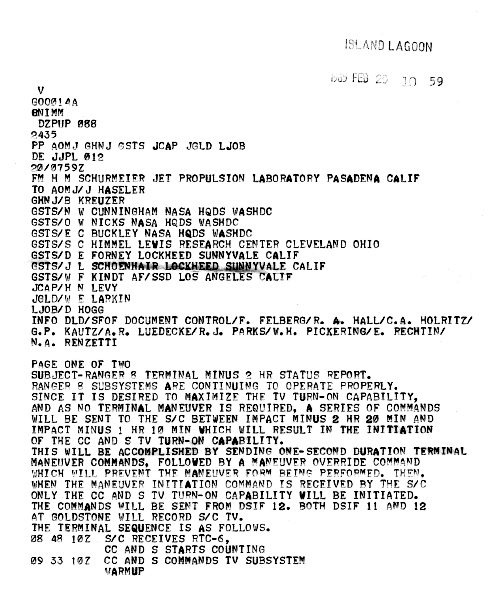 |
Ranger 8 status, Impact - 2 hours. 20 February 1965. Scan: Jan Delgado. |
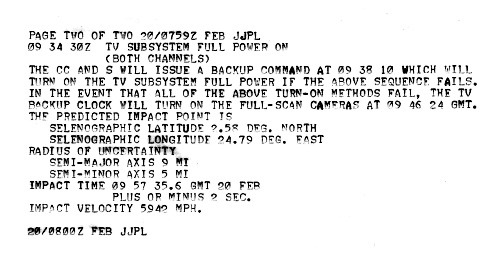 |
Ranger 8 status, Impact - 2 hours. 20 February 1965. Scan: Jan Delgado. |
Ranger 8 status, Impact + 1 hour. 20 February 1965. Scan: Jan Delgado. |
Ranger 9.
Ranger 9 was the last flight of the Program. Its launch date clashed with the first manned Gemini launch, so the Gemini III flight was delayed by a day. At 1637 EST on 21 March (0737 AEST 22 March) 1965, Ranger 9 speared through black clouds swirling around the launch pad and executed a faultless flight to land beside the 1050 metre high central peak in the crater Alphonsus at 12.83°S 2.37°W at 0608:20 PST on 24 March (0008:20 AEST 25 March), returning 5,814 images, nested concentrically, ie all the cameras were aimed at the same target.
For the first time the television pictures for this flight were broadcast around the country in real time with an interesting lash up using a Surveyor spacecraft’s electronic scan converter. It consisted of two sets of standard commercial vidicon cameras facing slow scan, long persistence monitors. Each set read the images appearing on its opposite number, effectively converting the 1132 lines per frame received from the Ranger camera into the US NTSC standard of 525 lines. The cameras were alternately switched to the television networks when its monitor had the most recent down linked image every 2.5 seconds, from either the A or B full scan camera.
Scientist Ray Heacock described what the viewers were seeing.
While Ranger 9 was on its way to the Moon the five-hour Gemini III mission was successfully completed.
Update 30 September 2022 –
Herb Younger recalls Ranger 9 support at the Echo site at Goldstone:
Island Lagoon’s Pat Delgado took this photo of the Echo site in 1965. Scan: Jan Delgado. |
“I came into the DSN just before Ranger 9 as the transmitter cognizant engineer. It was the last mission for the L-band equipment. L-band was due to be retired after Ranger 9, so I hadn’t paid much attention to it.
About 20 minutes before impact, my transmitter failed. That meant no 2-way doppler, which meant no data on lunar surface hardness, an important mission objective.
We were able to get the transmitter back up in time but of course we had to find the problem. Turned out to be an unsoldered connection in the transmitter filament supply. One which of course had worked fine for years until 20 minutes before its retirement.
I had a photo of that connection over my desk for years after that.”
…………………………………………..
The Ranger program ultimately provided over 17,000 pictures, and confirmed that the lunar surface seemed flat enough for an Apollo spacecraft to land on.
The Program taught the system engineers a lot, but the scientists found out very little. Was the lunar surface strong enough to support a spacecraft? What about soft, deep powdery dust that could gobble up a man? What if it was brittle foam rock that would cave in under the weight of a spacecraft? What was it made of?
That was for the Surveyor soft landing Program to find out.
Throughout his life Elmer Fredd has looked up proudly at the Moon and felt fortunate that he had access to the involvement in its exploration. “On the nights I worked late, I certainly had a love affair those days with the Moon each night it was visible.” He has often thought, “There’s hardware laying up there I’ve touched, tested and tweaked and circuitry I’ve designed.”
.....................................................................................................................................
Personal Interviews:
Elmer Fredd, RCA television design Engineer. Also thanks to Elmer for much of the television technical details.
Don Gray, Senior RF Engineer, Island Lagoon Tracking Station.
References:
Lunar Impact by R Cargill Hall. NASA SP-4210 (1977)
Ottto H Schade, National Academy of Engineering, Volume 2, pages 252-256 (1984).Illustrations and additions: Colin Mackellar.
